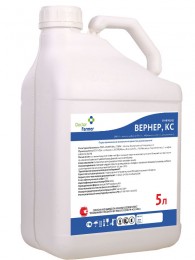
This chemical product is at the registration stage
| Eligible crops: | Cereal crops, Sunflower, Colza |
| Application: | Fungicides |
| Harmful sites: | Complex of airborne infections |
| Active materials: | azoxystrobin + tebuconazole + cyproconazole |
| Concentration: | 100+120+40 g/l |
| Chemical family: | strobilurins + triazoles |
| Formulation: | suspension concentrate, SC |
| Packing: | canister 5 l |
|
Consumption rate,
kg/ha
|
Culture | Harmful object |
Method, processing time,
application features
|
Waiting period (number of treatments) |
|---|---|---|---|---|
|
0,8-1 |
Spring and winter wheat |
Powdery mildew, leaf rust, stem rust, yellow rust, dwarf rust, pyrenophorosis, septoria leaf and ear blight | Spraying during the growing season; against fusarium and head blight in the end of heading – beginning of flowering phase. Working fluid consumption – 300 l/ha |
40(1) |
| 1 | Fusarium and ear mulch | |||
| 0,8-1 | Spring and winter barley | Powdery mildew, dwarf rust, stem rust, net spot, dark brown spot, rhynchosporium |
Spraying during the growing season. Working fluid consumption – 300 l/ha
|
|
| 1 | Spring and winter rape | Alternaria blight, fomoz, |
Spraying during the growing season when the first signs of disease appear (stem elongation phase - the beginning of the formation of pods in the lower tier).
Working fluid consumption -
400 l/ha
|
40(1-2) |
| Sunflower | Alternaria blight, white rot, gray rot, fomoz, rust |
Spraying during the growing season when the first signs of one of the diseases appear, subsequent spraying at intervals of 10-14 days, but no later than the end of budding - beginning of flowering phase. Working fluid consumption – 200-400 l/ha |
40(1-2) | |
| 0,8-1 | ||||
Advantages
Mechanism of action
We will contact you shortly.